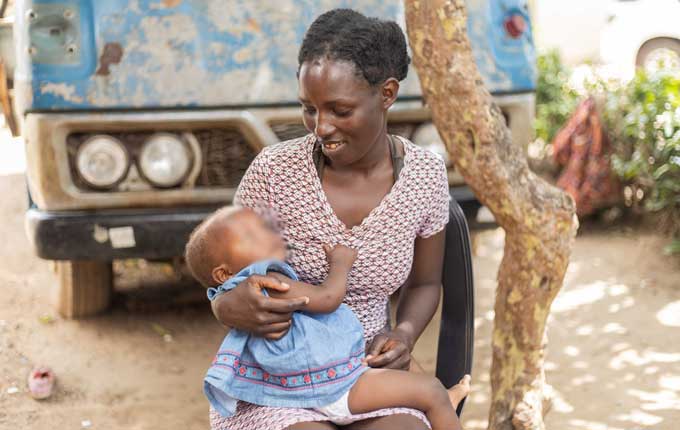
BY FARAI SHAWN MATIASHE When Patricia Mutee* took custody of her sister’s child in August last year in Kambuzuma, a high-density suburb in Harare, he had lost weight and had swollen feet.
That was a sign that the now four-year-old John Chaya was suffering from malnutrition.
Chaya’s mother had left him at just 19-months in the custody of her friend in Mufakose, a high-density suburb near Kambuzuma when she relocated to South Africa seeking greener pastures.
Malnutrition was not Chaya’s only problem; he also had bruises all over his body.
Mutee believes that Chaya was physically and emotionally abused by the woman, who was looking after him.
“It was my friends who told me that John was being abused.
“At such a young age, he was forced to do household chores including laundry and washing dishes,” she alleged.
“Neighbours told me that the woman used to beat John with household electric wires. He was suffering at her house.”
- Chamisa under fire over US$120K donation
- Mavhunga puts DeMbare into Chibuku quarterfinals
- Pension funds bet on Cabora Bassa oilfields
- Councils defy govt fire tender directive
Keep Reading
Mutee, a single mother of three who stays at her own house, took Chaya to Kuwadzana Polyclinic for a check-up.
She said Chaya could not even eat, walk or play soccer, his favourite sport, with other children in the neighbourhood.
At Kuwadzana Polyclinic, Chaya was admitted for treatment.
GOAL Zimbabwe, a humanitarian response agency headquartered in Ireland, is supporting City of Harare’s health department through LINKAGES programme, which is aimed at increasing nutrition status and reducing protection risks of vulnerable households in Harare and Bulawayo, funded by the European Union Humanitarian Aid.
The LINKAGES programme provides support for training and capacity-building on the identification and treatment of severe acute malnutrition (SAM) and moderate acute malnutrition (MAM) in children under the age of five to nurses at the Kuwadzana Polyclinic and community health workers in the same area.
Upon enrolment into the programme, Chaya was given plumpy nut, a peanut-based paste used to treat malnutrition.
A cash-based transfer of US$48 was also availed to the family and was collected at a local bank by Mutee.
“This is the money I used to buy food for the child including potatoes, vegetables and rice,” she said, caressing Chaya cheek as he stood beside her.
To cushion the families and to ensure the recovery of a child on therapeutic feeding, GOAL Zimbabwe is providing a cash based-transfer.
Each head per household gets US$12 per month for a maximum of three months.
Chaya recovered within the required three months and was given super cereal plus porridge for the next three months.
This is meant to ensure that the child’s health does not deteriorate again due to food insecurity after stopping the therapeutic feed.
“The porridge improved his appetite. John has gained weight. His health has improved.
Most people thought he was not going to make it,” said Mutee, pointing at Chaya who is now playful at home and always smiling.
Mutee survives on selling clothes at vending stalls in farming areas just outside Harare.
The woman who had taken custody of Chaya is self-employed.
Chaya’s mother, who is in South Africa, fled poverty in Zimbabwe and she last got in touch with Mutee in December last year.
They have since been trying to reach her with no success.
She does not assist her son with any financial support and the whereabouts of Chaya’s father are unknown, said Mutee.
Poverty and lack of knowledge on baby feeding are some of the major causes of malnutrition among children in urban areas of Zimbabwe.
The southern African nation is experiencing its worst economic crisis in decades with poor salaries, widespread poverty and uncontrolled inflation.
The situation has been worsened by the global Covid-19 pandemic.
More than five million Zimbabweans, a third of the population in both urban and rural areas, faced hunger between January and March 2022, when the harvest season began, according to the World Food Programme.
In 2020, the global acute malnutrition had increased to 4.5% from the 3.6% in 2019 with SAM reported at 2%, according to the Zimbabwe Vulnerability Assessment Committee’s 2020 report.
Valeria Nkhungwa, a nutritionist at the City of Harare responsible for Kuwadzana and Waterfalls, said poverty was a major cause of malnutrition in the community under her jurisdiction.
“Others rely on informal markets and they were affected by Covid-19,” Nkhungwa said.
“They could not afford to buy the basic food required.”
Ladisclous Machona, a nutrition volunteer at Kuwadzana Polyclinic, which serves a population of over 173 000 people, said when children come to the clinic for check-ups they assess complications.
“We use mid-upper arm circumference (MUAC) tape to take measurements,” Machona said.
“We admit the child according to the severity of the situation.
“Those without complications are treated as outpatients. We treat them using a plumpy nut and monitor them till recovery.
“Those with complications are referred to Harare Central Hospital for treatment.”
A MUAC tape is used to assess nutrition status and it has readings in centimetres, but mothers prefer colours that are easy to deduce meanings.
The MUAC is the circumference of the left upper arm, measured at the mid-point between the tip of the shoulder and the tip of the elbow.
Machona said nurses at the clinic have been equipped with identification and treatment skills for malnutrition and they pass the knowledge and skills to mothers.
Mothers are given MUAC tapes with the assistance of community health workers for them to measure their babies at home.
Machona said the cash-based transfer is motivating mothers to continue coming with their babies to the clinic for routine check-ups.
“We used to have cases of relapse,” he said.
“But that is decreasing. I believe it is because of the cash-based transfer which is encouraging mothers to return to the clinic for a check-up.”
At Kuwadzana Polyclinic, the defaulter rate was 50% from the period September 2020 to March 2021, but it has decreased to 12% in the same period, according to Machona.
There are 132 children who are currently admitted for treatment at Kuwadzana Polyclinic.
They also conduct sessions educating mothers on good breastfeeding practices.
The World Health Organisation (WHO) and United Nations Children’s Fund (Unicef) recommend that young children should be exclusively breastfed until the age of six months and then have continued breastfeeding along with nutritious solid food up to two years of age or beyond.
Since Chaya’s mother left him when he was just 19-months-old, this means he was breast-fed for less than two years as recommended by WHO.
Some people live far from Kuwadzana Polyclinic, forcing mothers to default when a child is admitted for malnutrition treatment. Health workers do outreach programmes in these hard-to-reach areas for screening and malnutrition treatment.
But Nkhungwa said others default because they have poor health-seeking behaviour.
In Nkulumane, a high-density suburb in Bulawayo, *Sibo Sibindi’s 11-month-old daughter, Andile Mathuthu*, who was underweight, started gaining weight within weeks of being given a plumpy nut.
“When we went to Njube Clinic, she was given a plumpy nut,” Sibindi said.
“She has recovered and was also given super cereal plus porridge. I also withdrew US$49 from the local bank for three months. I used the money to buy groceries for my family,” said the 33-year-old mother of three who stays with her unemployed husband at a family house.
Some people, however, are abusing the transfer. Instead of using the money to buy food for the baby, they used it to buy clothes, said Nkhungwa.
“I think it is best to give them vouchers so that they buy medicine and food,” she said.
“Cash-based transfers are prone to abuse and this ends up affecting the objectives of the project.”
Statistics from GOAL Zimbabwe show that 671 children have been admitted for treatment of malnutrition between June 2021 and March 2022 in Bulawayo and Harare Provinces while 323 children have been discharged.
For Chaya, his guardian, Mutee, is overwhelmed with a sense of joy as he is now mingling with others.
“It makes every parent happy to see a child running around and playing games with others,” she said.
*Names and places changed to protect children’s identity











